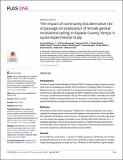| dc.contributor.author | Muhula, Samuel | |
| dc.contributor.author | Mveyange, Anthony | |
| dc.contributor.author | Oti, Samuel Oji | |
| dc.contributor.author | Bande, Martha | |
| dc.contributor.author | Kayiaa, Hellen | |
| dc.contributor.author | Leshore, Charles | |
| dc.contributor.author | Kawai, David | |
| dc.contributor.author | Opanga, Yvonne | |
| dc.contributor.author | Marita, Enock | |
| dc.contributor.author | Karanja, Sarah | |
| dc.contributor.author | Smet, Eefje | |
| dc.contributor.author | Conradi, Hilke | |
| dc.date.accessioned | 2021-09-10T21:10:58Z | |
| dc.date.available | 2021-09-10T21:10:58Z | |
| dc.date.issued | 4/28/2021 | |
| dc.identifier.citation | Muhula S, Mveyange A, Oti SO, Bande M, Kayiaa H, Leshore C, et al. (2021) The impact of community led alternative rite of passage on eradication of female genital mutilation/cutting in Kajiado County, Kenya: A quasi-experimental study. PLoS ONE 16(4): e0249662. https://doi.org/10.1371/journal.pone.0249662 | en_US |
| dc.identifier.other | . https://doi.org/ 10.1371/journal.pone.0249662 | |
| dc.identifier.uri | http://repository.amref.org/handle/123456789/240 | |
| dc.description | : © 2021 Muhula et al. This is an open
access article distributed under the terms of the
Creative Commons Attribution License, which
permits unrestricted use, distribution, and
reproduction in any medium, provided the original
author and source are credited. | en_US |
| dc.description.abstract | Introduction
In Kenya, Female Genital Mutilation/Cutting (FGM/C) is highly prevalent in specific communities such as the Maasai and Somali. With the intention of curtailing FMG/C prevalence in
Maasai community, Amref Health Africa, designed and implemented a novel intervention—
community-led alternative rite of passage (CLARP) in Kajiado County in Kenya since 2009.
The study: a) determined the impact of the CLARP model on FGM/C, child early and forced
marriages (CEFM), teenage pregnancies (TP) and years of schooling among girls and b)
explored the attitude, perception and practices of community stakeholders towards FGM/C.
Methods
We utilised a mixed methods approach. A difference-in-difference approach was used to
quantify the average impact of the model with Kajiado as the intervention County and Mandera, Marsabit and Wajir as control counties. The approach relied on secondary data analysis of the Kenya Demographic and Health Survey (KDHS) 2003, 2008–2009 and 2014. A
qualitative approach involving focus group discussions, in-depth interviews and key informant interviews were conducted with various respondents and community stakeholders to
document experiences, attitude and practices towards FGM/C
Results
The CLARP has contributed to: 1) decline in FGM/C prevalence, CEFM rates and TP rates
among girls by 24.2% (p<0.10), 4.9% (p<0.01) and 6.3% (p<0.01) respectively. 2) increase
in girls schooling years by 2.5 years (p<0.05). Perceived CLARP benefits to girls included:reduction in teenage marriages and childbirth; increased school retention and completion;
teenage pregnancies reduction and decline in FGM/C prevalence. Community stakeholders
in Kajiado believe that CLARP has been embraced in the community because of its impacts
in the lives of its beneficiaries and their families.
Conclusion
This study demonstrated that CLARP has been positively received by the Maasai community and has played a significant role in attenuating FGM/C, CEFM and TP in Kajiado, while
contributing to increasing girls’ schooling years. CLARP is replicable as it is currently being
implemented in Tanzania. We recommend scaling it up for adoption by stakeholders implementing in other counties that practice FGM/C as a rite of passage in Kenya and across
other sub Saharan Africa countries. | en_US |
| dc.language.iso | en | en_US |
| dc.publisher | PLOS ONE | en_US |
| dc.title | The impact of Community Led Alternative Rite of Passage on Eradication of Female Genital Mutilation/Cutting in Kajiado County, Kenya: A Quasi-experimental Study | en_US |
| dc.type | Article, Journal | en_US |

